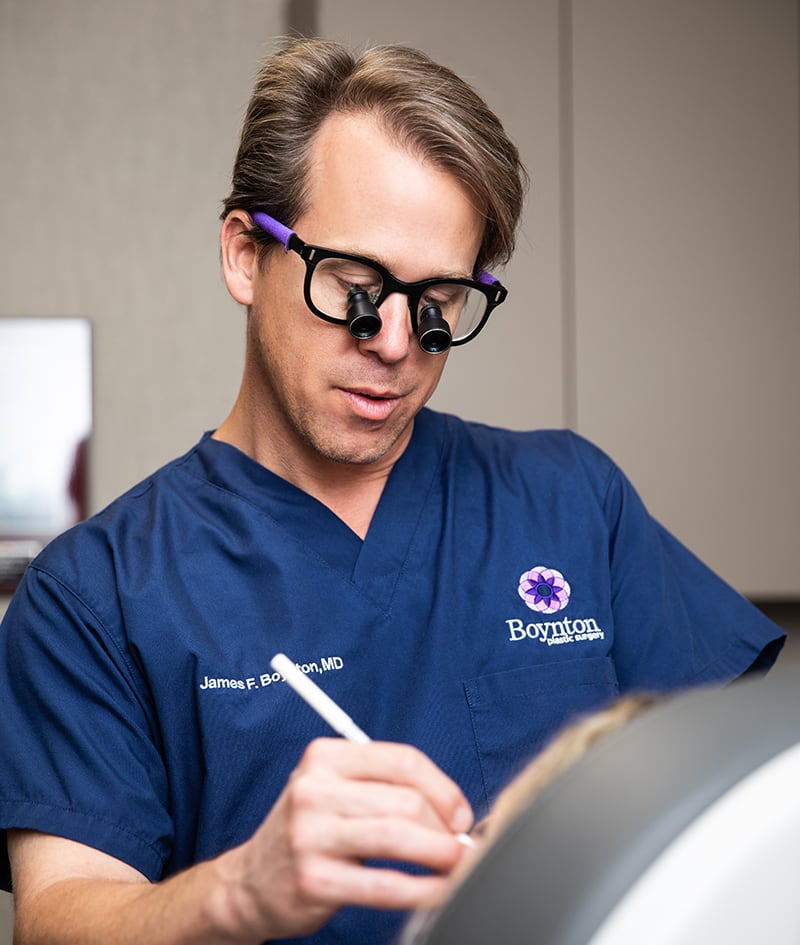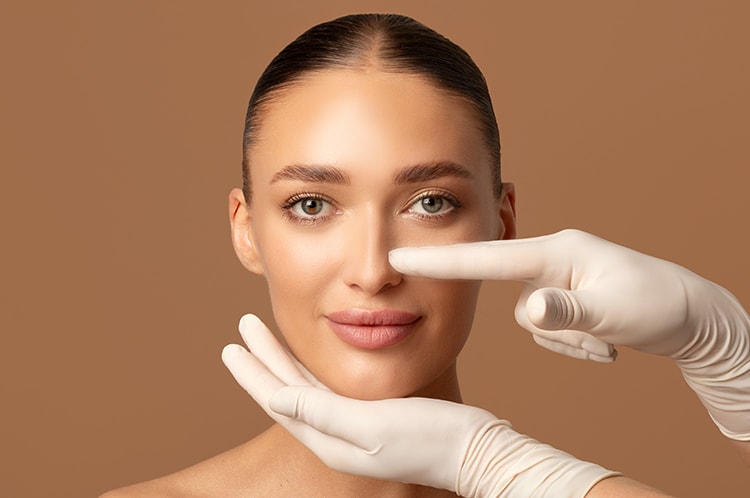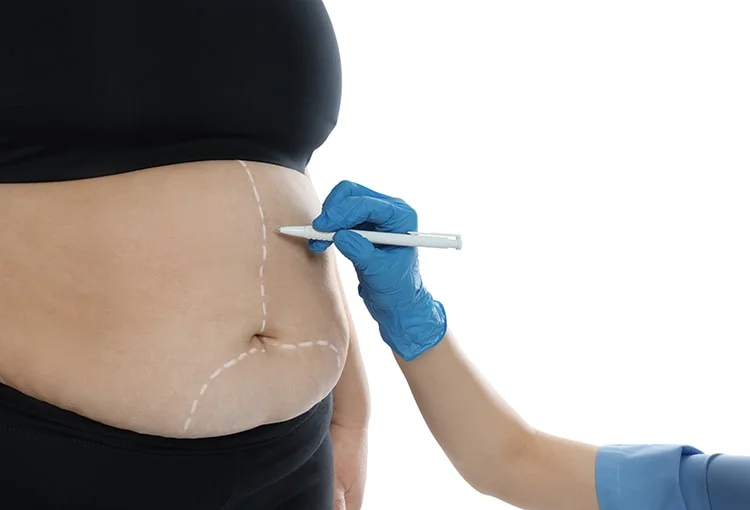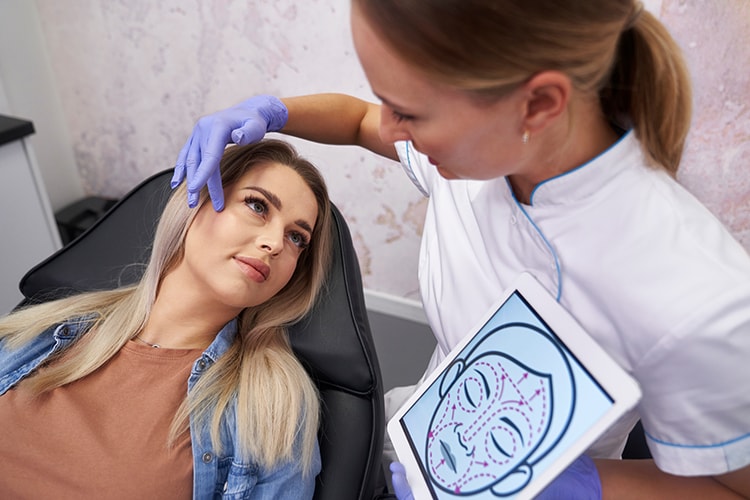Facelift
Board-certified plastic surgeon James F. Boynton, MD performs the full gamut of facial rejuvenation and restoration depending on a patient’s desires, changes that occur with aging, and goals. Included in this comprehensive assortment of procedures is facelift surgery, which continually ranks as one of the most popular aesthetic treatments performed each year due to its ability to resolve numerous signs of aging and high patient satisfaction.
At our practice, Dr. Boynton offers a variety of facelift treatments starting from the non-surgical, to minimally invasive, to more complex facelift procedures. Dr. Boynton always looks to develop an individual plan with each patient that accomplishes their goals in the least invasive way possible but still gives lasting results.The vast majority of our facelift procedures can be conveniently performed right here at our office with only local anesthesia and light oral sedation. With the use of minimally-invasive techniques, patients don’t have to stay overnight at hospitals and can recover in the comfort of their own home. They can also experience shorter recovery periods.
Facelift At a Glance
- Potential Benefits: The procedure is designed to lift and tighten sagging, lax skin in the mid- to lower facial area and the upper region of the neck, reduce signs of jowls, and smooth and firm the area for a more youthful appearance.
- Facelift Options: Full facelift/neck lift; mini facelift/neck lift.
- Procedure: Most of Dr. Boynton’s facelift procedures can be performed as “in-office” treatments with a local anesthetic and valium rather than general anesthesia. No overnight hospital stay is typically required.
- Recovery: In most cases, patients require about one week of recovery, with stitches removed one week following surgery. The recovery period is often shorter with the use of minimally-invasive techniques; however, the healing process depends on the specific facelift technique utilized and individual anatomical factors.
- Surgeon: Dr. Boynton is a board-certified plastic surgeon and facelift surgery is a special focus of his practice. His in-office, minimally-invasive facelift procedure is designed to reduce surgical risks while making the treatment and recovery process more efficient and convenient for patients. All facelift procedures are uniquely customized to produce natural-looking results that last long into the future.
- What Is a Facelift?
- Facelift Candidates
- Minimally-Invasive In-Office Facelift
- “Mini Facelift/Neck Lift”
- Full Facelift and Neck Lift
- Neck Lift and Neck Rejuvenation
- Other Facelift and Facial Rejuvenation Options
- Facelift Recovery
- Facelift Results
- Facelift Scars
- Facelift Cost
- Non-Surgical Facelift
- How to Choose the Best Facelift Surgeon
- Additional Facelift FAQs
What Is a Facelift?
Facelift surgery is a cosmetic procedure designed to rejuvenate one’s appearance through the lifting and tightening of skin and underlying facial/neck tissue. Depending on a patient’s needs and concerns, this treatment can help smooth lines and wrinkles, eliminate excess skin and jowling, combat skin sagging, restore lost facial volume, and tighten muscle band laxity in the neck (known as the platysma). By customizing each facelift to meet the specific goals of the individual, Dr. Boynton is able to help patients achieve the more youthful facial aesthetic they desire with results that appear entirely natural. A facelift and a neck lift in many cases are “interlinked” as one procedure; however, most times colloquially it is referred to as a “facelift.”
Who Is a Good Candidate for Facelift Surgery?
Generally speaking, candidates for facelift surgery are often bothered by one or more of the following cosmetic concerns:
- Loose, sagging skin in the face and neck
- Moderate to significant lines and wrinkles (including nasolabial folds) and downturning of the corners of the mouth (which can give a frowning-like appearance)
- Loss of volume in the cheeks, as well as flattening of the cheeks, and midface
- Excess and/or displaced fat throughout the face and neck
- Noticeable jowling
In addition to wanting to correct the above issues, patients need to be in good overall health with no unmanaged health concerns that may inhibit proper healing to be considered a good candidate for facelift surgery. Ideally, patients should also be non-smokers (or have quit using all tobacco products, including E-cigarettes, at least two weeks before surgery) and have realistic expectations for what can be accomplished with treatment. Dr. Boynton will discuss all of this criteria in complete detail at the time of the consultation, helping to determine the most appropriate course of action based on your unique case.

What Is a Minimally-Invasive, In-Office Facelift?
A minimally-invasive, in-office facelift basically describes a facelift that employs techniques that can provide effective results without the need to visit an off-site outpatient surgical facility or spend excessive amounts of time recovering from the procedure. These types of facelift procedures can be ideal for patients experiencing noticeable signs of age and inelastic skin in the mid- to lower face and/or upper neck; however, the concerns may not be severe enough to necessitate a more invasive type of facelift. Minimally-invasive facelifts can allow for very well-concealed scars so that women can feel free to put their hair up and men can cut their hair very short (or even shave their heads, in some cases) without worrying about noticeable scarring. Minimally-invasive facelift procedures also offer an alternative for patients who may be experiencing “filler fatigue,” giving both women and men the opportunity to obtain natural-looking results that can last for many years.

What Is a “Mini Facelift/Neck Lift”?
Some patients—generally those who have too much excess skin, sagging jowls, etc.—may need more than a non-surgical facial rejuvenation option, such as a liquid facelift (described in its section below), can effectively accomplish. These patients often benefit from a more comprehensive approach called the short-scar facelift and neck lift. Dr. Boynton has been trained in many different types of facelift techniques; however, for younger patients in their 40s and 50s who mostly complain of jowling in the lower face, he has found one of the most ideal solutions to be the mini face/neck lift. This eliminates the vast majority of the scar behind the ear and along the lower hairline that is included in a “classic facelift,” or “full facelift,” that is often more visible when women wear their hair up. This also leads to a faster recovery and is mostly done in a simple office setting under local anesthesia with valium alone. Dr. Boynton’s technique performing the mini facelift has evolved a bit over the years. Originally it was a true short-scar facelift, meaning the incision stopped at the bottom of the earlobe. Now the incision typically goes very well concealed behind the ear, but still not down the hairline—you still don’t see any incisions. In cases where that needs to be performed, Dr. Boynton utilizes a specialized technique developed by one of the masters of hair transplantation to keep this incision concealed within the hairline.
Dr. Boynton’s mini facelift and neck lift procedures are typically performed in the office without traditional hospital care, anesthesia, or overnight stay. Patients often enjoy not having to go to a hospital, and most are very comfortable with local anesthesia and valium medication for mild relaxation. Some benefits of this procedure may include a much faster recovery than a traditional facelift because of limited incisions, as well as not having to undergo anesthesia. It is also more economical for patients since there is generally no hospital stay.
The mini facelift and neck lift involves a well-concealed incision that typically avoids the classical, longer incisions behind the ear that often extend down the back of the hairline. This has always been the most objectionable part of a facelift incision to most patients since the behind-the-ear incision can be seen (especially in patients that like to wear their hair up in a ponytail). Additionally, a small incision may need to be made under the chin that allows direct access to sculpting and thinning of any fatty tissue in this area, as well as the platysmaplasty—which is the neck tightening procedure that works like an internal “bolster” in the neck while really helping to sharpen and define the neck line. However, Dr. Boynton is able to avoid the chin incision in some cases if it is possible to produce similar results by utilizing just the primary incisions.
Cheek Lift
It is important to note that a “mini facelift” is often a term that can be used to describe a number of popular treatments at Dr. Boynton’s practice because it is capable of addressing several common concerns. In Dr. Boynton’s hands, a mini facelift is essentially the same as a “jowl lift,” “lower facelift,” and a “cheek lift.”
What is commonly known as a cheek lift (a.k.a. a “mini facelift” at our practice) is defined as a surgical procedure capable of smoothing away signs of age in the cheeks. This treatment can also enhance the lower eyelid areas by reducing under-eye hollows and creating a more youthful and refreshed look in the middle region of the face. Cheek lift surgery offers a variety of potential benefits for both women and men. The procedure can make sagging skin in the area look and feel firmer, and it can minimize signs of nasolabial folds and wrinkles. In the cheek area, Dr. Boynton separately raises the skin and performs a cheek lift. He then tightens the SMAS and lateral platysma (muscle), or deep tissue layer of the face, using a specialized technique to plicate or maximally tighten and suspend the jowl. The tightening of the deep layer of the face and the platysmaplasty really help to ensure a lasting result.
Ultimately, Dr. Boynton seeks to achieve very natural results that are not over-tight or over-pulled. Results from the mini facelift and neck lift are meant to highlight each patient’s natural beauty without changing the way they look. Following the procedure, patients typically need approximately one week to recover.
Full Facelift and Neck Lift
A traditional, full facelift and neck lift may be recommended for patients who are experiencing signs of severe jowling, wrinkles, and loose skin in the mid- to lower face and along the neck. This treatment can provide exceptional results with outcomes that last many years into the future as long as proper skin care is maintained. A full facelift involves the careful placement of an incision in discreet areas—usually above the hairline and following from the temples to the region behind the ear and down the occipital hairline behind the ear (but still well concealed). This allows the surgical scars to mostly remain well-concealed and difficult for others to notice. Dr. Boynton will delicately tighten underlying facial muscles and trim away excess skin. The remaining skin is then smoothed to create a more youthful aesthetic. Dr. Boynton is extensively experienced with facelift procedures and utilizes techniques that can provide a firmer appearance without an artificial or “windswept” look. The goal is to effectively take years off of one’s appearance with results that look both beautiful and natural. If the neck is also being addressed during a facelift (which is usually the case), another incision will be made to allow Dr. Boynton to tighten the muscles, eliminate excess skin, and pull the remaining skin taut for smoother results and an improved neck contour.
Neck Lift and Neck Rejuvenation
Many individuals who have concerns that can be addressed by a facelift procedure simultaneously experience concerns with the appearance of their neck, as well. In most cases, a surgical neck lift or other neck rejuvenation treatment can be performed in tandem with a facelift procedure to provide comprehensive rejuvenation of the mid- to lower face and the neck. If neck rejuvenation alone is all that’s necessary to meet the patient’s goals, aesthetic neck treatments can be performed as standalone procedures.
Dr. Boynton offers several neck lift and neck rejuvenation options, including neck liposuction (neck lipocontouring), the state-of-the-art Suture Suspension Neck Lift – which sharpens the cervicomental angle with a suture and is less invasive than a full neck lift, and T-Z Plasty (also known as a central or direct neck lift), which can remove “the turkey gobbler” centrally and most directly with a single incision in less than an hour and has appeal in certain men that do not want a facelift. A T-Z Plasty can be done without a facelift and involves removing lax skin, thinning central neck fat, and tightening the neck muscle that serves as an internal “hammock,” also called the platysma—this is known as a platysmaplasty.
Other Facelift and Facial Rejuvenation Options
Liquid Facelift
Starting sometimes in their 30s, but definitely in their 40s, most individuals show changes of aging in their face that begin to bother them. Facial aging is affected by genetics, exposure to or history of smoking, and sun exposure. In many patients with “early” signs of aging, non-surgical injectables can restore and rejuvenate the face without a lengthy recovery. BOTOX® Cosmetic is a popular method of restoring the appearance of the forehead, and it can also elevate the brow to some degree (i.e. a “BOTOX brow lift”), as well as improve crow’s feet lines on the sides of the eyes.
Patients also start to lose “fat” in the central aspects of their faces, in particular the perioral region around the mouth, and get heavier “smile lines” or nasolabial folds about this time. There are a variety of fillers (JUVÉDERM VOLUMA®, JUVÉDERM® Ultra Plus, JUVÉDERM VOLBELLA®, RADIESSE®, Sculptra® Aesthetic, Restylane®, Restylane® Lyft, Restylane® Defyne and Refyne, as well as BELOTERO BALANCE®) that can add volume back in this area, as well as into the corners of the mouth and jawline area. All of this done together is essentially a “liquid facelift,” which can restore a number of concerns in areas of the face without incisional surgery.
Micro and Nanofat Injections to the Face (Fat Injections to the Face)
Fat injections to the face have been around for some time, however it has only been in recent years that the technology and refinement in instrumentation and technique have allowed for “small particle” fat injections that don’t leave “lumpiness” and can truly add some stem cell effects and rejuvenation to the under-eye region, areas of the cheeks, and around the mouth. Nano and microfat injections truly take the results of every facelift up another notch, and this is a nice added procedure for patients. For patients who opt to include facial fat injections in their treatment plan, Dr. Boynton typically performs this step in a subsequent appointment following the in-office facelift procedure.
All of these procedures are offered in the comfortable setting of Dr. Boynton’s office without the need to go under full anesthesia or to a hospital unless requested.
What Is Recovery from Facelift Surgery Like?
Recovery following a facelift will depend on the specific technique employed, as well as one’s natural healing process. After a liquid facelift, there may be some degree of swelling and/or bruising in the targeted areas, though these symptoms are generally minimal and should fade relatively quickly. Whether performed alone or in combination with liposuction or with certain neck lift/rejuvenation procedures, many individuals are able to return to normal activities the following day.
When the short-scar facelift and neck lift are performed, patients can usually expect some bruising, swelling, and/or tenderness to occur initially throughout the treated region. Like the liquid facelift, these side effects are temporary and should resolve over time. Any discomfort experienced can typically be managed with medication, and the majority of women and men are able to resume office jobs, school, and other non-strenuous activities after approximately one week. Any heavy lifting, intense exercise, and other strenuous physical actions will need to be avoided for a bit longer to help ensure proper healing.
Recovery from a full/traditional facelift is different among patients depending on the technique utilized and the individual’s unique anatomical response. Temporary swelling and bruising in the treatment areas can be expected in the days and weeks following full facelift surgery; however, these effects should fade as the areas continue to heal. Some patients may need at least two to three weeks of recovery before resuming normal daily activities. Dr. Boynton can provide recommendations on when to resume work or strenuous exercises routines based on each patient’s needs.
How Long Do Facelift Results Last?
The length of results from a facelift will depend on the technique that is performed. A liquid facelift utilizing only injectable treatments is designed to yield long-lasting, though temporary, results. When the effects of the injectables begin to fade, patients will need follow-up injectable treatments to maintain the outcome. A mini facelift is designed to produce results that can last 5-10 years with the proper care, and a full/traditional facelift may yield outcomes that last up to 10 years or longer with good skin care and excellent maintenance of general health. The overall quality of an individual’s skin and genetic factors will play a part in terms of how long the outcome can last. With that in mind, there are other factors involved in maintaining results that are completely within your control. A healthy diet, adequate skin protection from the sun’s harmful rays, a good at-home skin care regimen, keeping a stable weight, and living a generally healthy lifestyle can go a long way toward maintaining the effects of facelift surgery years into the future.
How Noticeable are Facelift Scars?
One of the major benefits of both liquid facelift and short-scar facelift techniques is the inconspicuous nature of residual scars. For patients who undergo the liquid facelift technique without additional liposuction or neck lift treatment, there are no surgical incisions at all; therefore, there should be no residual scarring whatsoever. For individuals who have the short-scar facelift, incisions are extremely well-concealed as they are placed in very discreet areas. Indeed, the very design of this technique aims to minimize scarring; scars from this type of facelift surgery should be rather small and well-hidden. Even scars from a full/traditional facelift can be difficult to detect depending on their precise placement and the patient’s hairstyle. Plus, scarring typically fades to some degree over time.
How Much Does a Facelift Cost?
Here at Boynton Plastic Surgery, the price of facelift surgery often starts in the range of $11,000 – $12,000 and upwards depending on the complexity of the treatment. With that in mind, it’s important to note that this treatment is customized, so the total cost of a facelift will depend on several different factors. These include the specific concerns being addressed, the particular technique utilized, whether or not additional treatments are being performed to provide an even greater enhancement, and other components. Due to this number of variables, an in-office consultation will be necessary to determine pricing. At this time, Dr. Boynton will listen to your aesthetic desires, perform a complete facial evaluation, and formulate a custom treatment plan that can help you achieve your goals. Based on the proposed approach, he can then provide a close approximation of the overall cost of your facelift surgery.
At Boynton Plastic Surgery, we never want the price of treatment to keep patients from receiving the cosmetic care they desire, which is why we have partnered with CareCredit® to offer several plastic surgery financing options. With a variety of choices available, qualified applicants can find a monthly payment plan that enables them to comfortably cover the cost of facelift surgery with little to no interest.
Is it Possible to Have a Facelift without Surgery?
While no other procedure will have results that are as extensive or that last as long as a surgical facelift, it is possible for many patients to achieve significant facial rejuvenation without surgery. As noted in the section above, a liquid facelift utilizing cosmetic injectables and dermal fillers can smooth out fine lines, add volume to facial features, and give the face a more refreshed and youthful appearance. Non-surgical options like laser skin resurfacing and chemical peels can also be effective for reducing signs of age and skin damage. If your aesthetic concerns are fairly mild or minimal, or if you simply want to avoid surgery at this time, these less invasive treatments may be suitable options for your needs. During your initial consultation, Dr. Boynton can help you determine the best course of treatment for your goals.
“I really loved my whole experience with Dr. Boynton and I am extremely happy with my results! From the beginning, I was confident that Dr. Boynton understood exactly what I wanted to achieve. I appreciate all of the time Dr. Boynton and his staff spent to make me feel comfortable and make sure I understood the procedure and what to expect. I would recommend Dr. Boynton to any one of my friends or family.”
How to Choose the Best Facelift Surgeon
Choosing the plastic surgeon who will be performing your facelift is the first step toward achieving your goals, and it is best to do some thorough research from the outset. Here is some criteria to keep in mind as you begin your search for the ideal facelift surgeon:
Experience, Credentials, and Professional/Educational History
You should be able to find some detailed information on a prospective facelift surgeon’s credentials and background on the practice’s website. This information is crucial for patients trying to get an idea of a plastic surgeon’s overall skills and experience. If the surgeon is certified by the American Board of Plastic Surgery, this is a good indication that the doctor has gone well above and beyond the standard requirements to practice, and has a solid dedication to ethics, safety, and continuous education to remain abreast of new treatments and techniques. Researching a doctor’s biographical history can also let you know about various honors and awards they have received, as well as memberships in respected and prestigious organizations.
Surgical Techniques
A surgeon’s commitment to the use of advanced techniques should be evaluated during your search. The field of plastic surgery has progressed in several ways over the years, often making certain kinds of treatment more convenient and better able to achieve results that look natural. For instance, Dr. Boynton’s embrace of state-of-the-art facelift techniques has made it possible for him to perform many types of these treatments right here at our office rather than an offsite surgical facility. Additionally, these advanced techniques often reduce the need for general anesthesia in many cases (which diminishes the risk of surgery) and even quicken recovery for many patients.
Reviews from Patients and Visual Record of Results
A look at patient reviews and before-and-after photo galleries can be very helpful. Reviews chronicling other individuals’ experiences with a particular surgeon can often provide a general overview as to the kind of treatment that can be expected, while before-and-after photos offer a visual record of the results for which the doctor is capable of achieving.
Approach to Care
Finally, an in-person consultation should be scheduled once the selection of potential plastic surgeons has been narrowed down. This meeting can help you get to know the surgeon a bit and determine whether they are a good fit for your needs. The initial consultation allows you to evaluate your rapport and establish your level of comfort and confidence in the doctor’s skills, abilities, attentiveness, and style of communication.

Additional Frequently Asked Questions About Facelift
Does a facelift always include a neck lift?
Traditional facelift surgery usually includes a certain degree of neck lifting. This helps to balance the lower facial rejuvenation by addressing loose, inelastic skin that may have collected in the upper neck, as well. With this in mind, not all patients will need a neck lift along with a facelift. Dr. Boynton will evaluate your skin and talk with you about your overall concerns during the initial consultation to determine whether neck lifting will be a necessary component of your facelift treatment plan.
Is there a specific age limit for facelift surgery?
Facelift surgery does not have an upper age limit. In fact, an adult’s age is not even among the major factors taken into account when evaluating candidacy for this treatment. The factors that will be determinative include the patient’s current health status, medical history, and whether facelift surgery is an appropriate option for the patient’s specific enhancement goals. Individuals in their 60s and beyond have been successfully treated with facelift surgery.
Is facelift surgery different for women vs. men?
The surgical techniques for facelift differ slightly depending on whether the patient is female or male. Most women and men consider this treatment as a way to help them look more youthful and refreshed; however, differences among anatomical characteristics and specific goals patients want to achieve necessitate a distinct approach. Men frequently desire enhanced jawline definition for a sharper contour, along with firmer and smoother skin. While women also typically wish to improve their lower facial contours, they often desire a softer aesthetic result. The specific placement of the surgical incisions may also vary among women and men. Facelift surgery frequently requires incisions in the hairline so the residual scars can remain discreet. For men who have receding hairlines, Dr. Boynton may recommend incision placement in areas that are less conspicuous. Fortunately, all of Dr. Boynton’s facelift procedures are uniquely customized to each patient in order to produce the best possible results.
How can I reduce swelling after facelift surgery?
Facelift surgery will produce swelling. This is a normal side effect of surgery and should fade with time. The most severe degree of swelling will typically occur in the first two weeks after treatment. During this time, there are some things patients can do to help control or reduce the swelling. One of the most important steps to take is to be sure that your head is in an elevated position as much as possible, even while sleeping. Some extra pillows to keep your head propped up during the night can help. A few dietary precautions can also help control swelling after facelift surgery. Foods like leafy greens, fruits, vegetables and others that contain antioxidants, vitamins, and protein are often good options to embrace. It is best to avoid or at least minimize foods and beverages that contain high levels of salt, as that can exacerbate inflammation. Dr. Boynton will provide a detailed post-operative guide with instructions on how you can experience the smoothest recovery possible.
When can I exercise again after facelift surgery?
For a full facelift, most patients are advised to avoid strenuous exercise for approximately three weeks following surgery. However, each patient’s needs are different depending on their unique response to treatment and the particular facelift technique that has been performed. Dr. Boynton will be able to provide recommendations more specific to each patient’s case upon evaluation.
Schedule a Facelift Consultation
If you would like to learn more about how facelift surgery can help you meet your goals, please contact Dr. Boynton to schedule a consultation. He can discuss all aspects of a facelift with you and answer any questions you may have.






